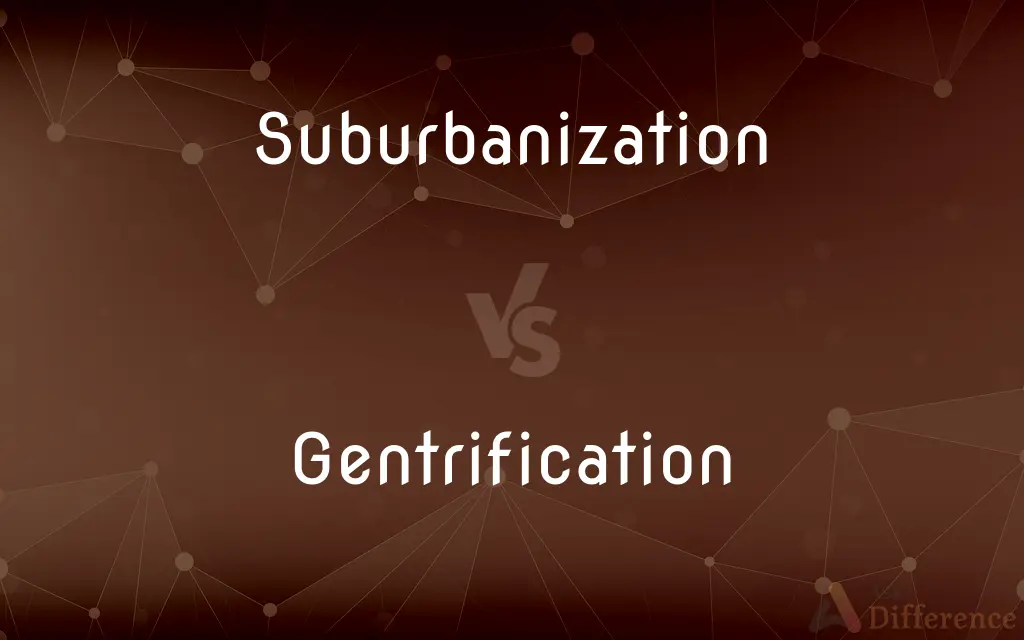Suburbanization vs. Gentrification — What's the Difference?
Edited by Tayyaba Rehman — By Fiza Rafique — Updated on March 30, 2024
Suburbanization expands urban areas to outskirts for space and quality of life, while gentrification sees wealthier people move into poor areas, raising values and displacing residents.

Difference Between Suburbanization and Gentrification
Table of Contents
ADVERTISEMENT
Key Differences
Suburbanization typically occurs when individuals or families move from an urban core to the suburbs in search of larger living spaces, better schools, and a perceived higher quality of life. This movement is driven by the desire for a more comfortable and less congested living environment. On the other hand, gentrification is marked by the influx of wealthier individuals into poorer urban neighborhoods, leading to renovation of deteriorated urban property, rising property values, and often the displacement of the existing, lower-income residents. While suburbanization spreads the urban fabric into new areas, gentrification transforms existing urban spaces.
The drivers behind suburbanization include the availability of affordable housing, the desire for a suburban lifestyle, and, historically, policies that incentivize suburban growth. Gentrification is driven by the search for housing in central urban locations, investment opportunities, and the appeal of urban lifestyles to a wealthier demographic. These processes are influenced by different socioeconomic factors and policy environments, highlighting distinct urban development dynamics.
Suburbanization often leads to the development of residential communities with single-family homes and the expansion of road networks and automobile dependency. Conversely, gentrification can lead to the revitalization of urban cores, with improvements in infrastructure and services but also the risk of eroding the area’s original character and diversity. The contrast between spreading outwards and upgrading inward illustrates the different impacts on urban landscape and mobility.
Suburbanization has been associated with the pursuit of safety, community, and a family-oriented environment, often resulting in homogeneous communities. Gentrification, while it can bring diversity and renewal to urban neighborhoods, often sparks controversy over issues such as displacement, social stratification, and the loss of cultural heritage. These processes reflect differing impacts on community cohesion and social dynamics.
Suburbanization can lead to the decentralization of economic activities, with businesses relocating to or emerging in suburban areas to serve the growing population. Gentrification, meanwhile, tends to increase property values and attract new businesses and services, which can alter the economic landscape of urban neighborhoods. Both phenomena reshape the economic contours of regions but through divergent pathways.
ADVERTISEMENT
Comparison Chart
Definition
Expansion of urban areas into the suburbs, driven by migration for more space and quality of life.
Wealthier individuals moving into and revitalizing economically depressed urban areas, often displacing lower-income residents.
Primary Drivers
Affordable housing, suburban lifestyle preference, transportation infrastructure.
Central location appeal, investment opportunities, urban lifestyle preference.
Urban Impact
Leads to the development of new residential areas and increased automobile use.
Revitalizes urban cores, improves infrastructure, but may erode area’s original character.
Social Impact
Often results in homogeneous communities focused on safety and family life.
Can introduce diversity but also controversy over displacement and cultural erosion.
Economic Impact
Can decentralize economic activities and encourage commercial development in suburbs.
Increases property values, attracts new businesses, but may alter neighborhood economies.
Compare with Definitions
Suburbanization
The process of population movement from within cities to the outskirts.
Suburbanization in the 1950s led to the growth of suburb communities.
Gentrification
The transformation of neighborhoods by wealthier individuals, often displacing original residents.
Gentrification of the downtown area pushed out many long-time residents.
Suburbanization
Expansion of suburban areas due to urban sprawl.
The city's suburbanization was fueled by new highway constructions.
Gentrification
Economic and social change in urban neighborhoods due to investment.
Gentrification has changed the neighborhood’s character and demographics.
Suburbanization
Migration trend from cities to suburban areas for more space.
Families sought larger homes, contributing to suburbanization.
Gentrification
Revitalization of urban areas, leading to increased property values.
The old industrial district's gentrification attracted new businesses.
Suburbanization
Shift from urban to suburban living environments.
The desire for a quieter life has accelerated suburbanization.
Gentrification
Influx of affluent people into lower-income urban areas.
The city's historic district experienced gentrification with new luxury condos.
Suburbanization
Development of residential and commercial areas in the suburbs.
Suburbanization has seen the rise of shopping malls outside urban centers.
Gentrification
Process of urban renewal that can lead to displacement of residents.
Gentrification in the area sparked debates over housing affordability.
Suburbanization
Suburbanization is a population shift from central urban areas into suburbs, resulting in the formation of (sub)urban sprawl. As a consequence of the movement of households and businesses out of the city centers, low-density, peripheral urban areas grow.
Gentrification
Gentrification is the process of changing the character of a neighborhood through the influx of more affluent residents and businesses. Because it tends to change the character of said neighborhood, it is a common and controversial topic in politics and in urban planning.
Suburbanization
To render suburban; impart a suburban character to.
Gentrification
The process of renovating and improving a house or district so that it conforms to middle-class taste
An area undergoing rapid gentrification
Suburbanization
The process of suburbanizing, of population movement from cities to suburbs
Gentrification
The restoration and upgrading of deteriorated urban property by middle-class or affluent people, often resulting in displacement of lower-income people.
Gentrification
(urban studies) The renewal and rebuilding that accompanies the influx of middle class or affluent people into deteriorating areas and often displaces earlier, usually poorer, residents; any example of such a process.
Gentrification
The restoration of run-down urban areas by the middle class (resulting in the displacement of lower-income people)
Common Curiosities
What is suburbanization?
Suburbanization is the movement of populations from urban centers to the suburbs, often in search of more space and a perceived higher quality of life.
How does gentrification impact urban neighborhoods?
Gentrification revitalizes urban neighborhoods but can lead to increased property values and displacement of lower-income residents.
Why do people choose suburbanization?
People choose suburbanization for affordable housing, larger living spaces, and a desire for a suburban lifestyle.
What drives gentrification in cities?
Gentrification is driven by the search for central urban locations, investment opportunities, and the appeal of urban lifestyles to wealthier individuals.
Can suburbanization affect the environment?
Yes, suburbanization can lead to increased automobile dependency and spread of urban sprawl, impacting the environment negatively.
What are the economic consequences of suburbanization?
Suburbanization can decentralize economic activities, leading to commercial development in suburban areas.
How does gentrification affect local communities?
While it can bring investment and diversity, gentrification often displaces existing residents and can erode the area’s cultural heritage.
Is gentrification always negative?
Not necessarily; it can lead to positive changes such as revitalization and improved infrastructure, but it requires careful management to minimize negative impacts.
What policies can manage the effects of suburbanization and gentrification?
Policies that promote affordable housing, sustainable urban growth, and equitable development can help manage the effects of both phenomena.
How do suburbanization and gentrification differ in their impact on urban development?
Suburbanization expands the urban area into the suburbs, while gentrification revitalizes urban cores but may displace lower-income residents.
Share Your Discovery

Previous Comparison
Endocytosis vs. Transcytosis
Next Comparison
Afro vs. FroAuthor Spotlight
Written by
Fiza RafiqueFiza Rafique is a skilled content writer at AskDifference.com, where she meticulously refines and enhances written pieces. Drawing from her vast editorial expertise, Fiza ensures clarity, accuracy, and precision in every article. Passionate about language, she continually seeks to elevate the quality of content for readers worldwide.
Edited by
Tayyaba RehmanTayyaba Rehman is a distinguished writer, currently serving as a primary contributor to askdifference.com. As a researcher in semantics and etymology, Tayyaba's passion for the complexity of languages and their distinctions has found a perfect home on the platform. Tayyaba delves into the intricacies of language, distinguishing between commonly confused words and phrases, thereby providing clarity for readers worldwide.














































